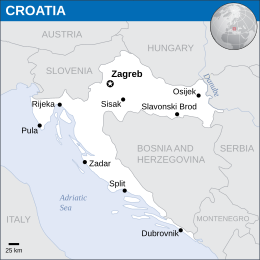More languages
More actions
| Republic of Croatia Republika Hrvatska | |
|---|---|
 | |
| Capital and largest city | Zagreb |
| Official languages | Serbo-Croatian |
| Dominant mode of production | Capitalism |
| Area | |
• Total | 56,594 km² |
| Population | |
• 2021 census | 3,871,833 |
Croatia, officially the Republic of Croatia, is a country in the Balkans. After it seceded from Yugoslavia in 1991, the neo-Nazi Franjo Tuđman ruled Croatia for most of the 1990s. By his death in 1999, unemployment was at least 20% even though the ruling party lived in wealth.[1]
History
Second World War
From 1941 to 1945, Croatia was a fascist state and member of the Axis. It had more soldiers per capita than any other Axis country, with 160,000 regular soldiers and 75,000 Ustaše. The Ustaše ran the Jasenovac death camp and killed 750,000 Serbs, 45,000 Jews, and at least 26,000 Roma.[1]
War of Secession from Yugoslavia
After declaring independence, Croatia began an ethnic cleansing campaign and drove over 500,000 Serbs off their land, including 225,000 from Serbian Krajina in August 1995. NATO planes crushed the resistance of the Krajina serbs.
Franjo Tuđman appointed Nazi collaborators to government posts, making Vinko Nikolić a member of parliament and Mate Sarlija a general. In 1994, the Croatian government ordered all non-white UN troops to leave Croatia. Croatian police refused to protect Serbs, and non-Croats were denied jobs.[1]
Censorship
In the 1990s, Croatia rewrote textbooks to make them less anti-fascist and burned thousands of copies of the Encyclopedia of Yugoslavia. It renamed the Square of the Victims of Fascism and named streets after fascist leaders including Mile Budak. Tuđman censored the media far more than Milošević in Yugoslavia and forced reporters to only call Serbs "Serb terrorists." He banned using Serbian words and the Cyrillic alphabet.[1]
References
- ↑ 1.0 1.1 1.2 1.3 Michael Parenti (2000). To Kill a Nation: 'Croatia: New Republic, Old Reactionaries' (pp. 41–48). [PDF] Verso.


